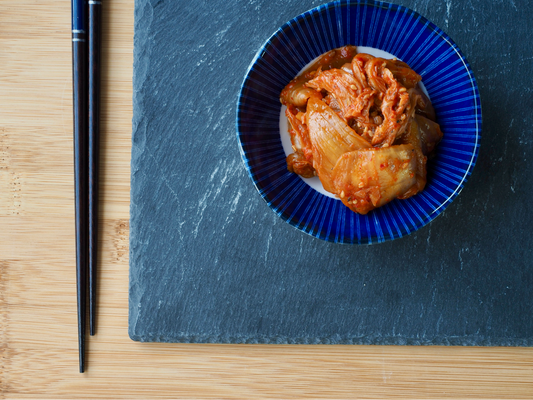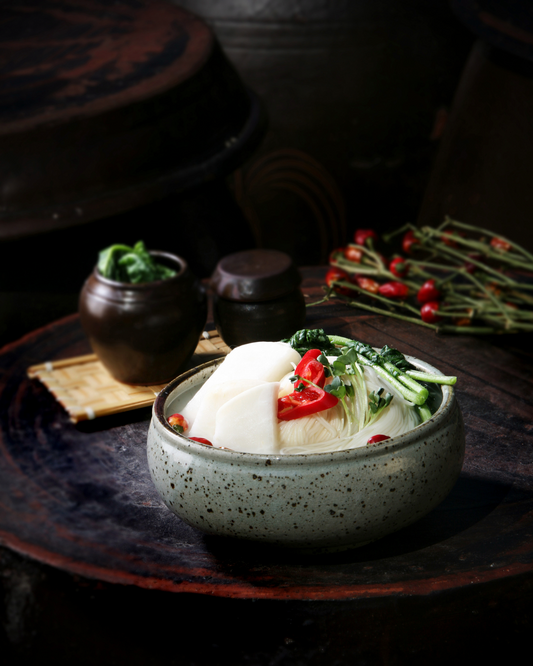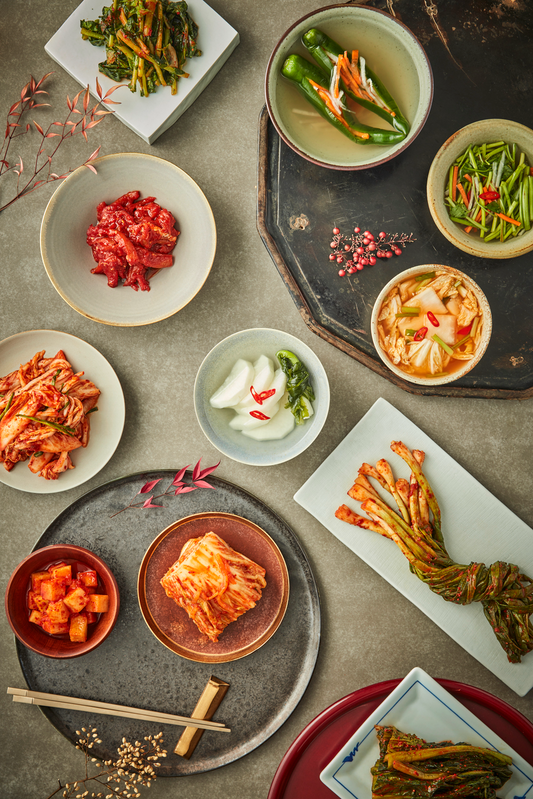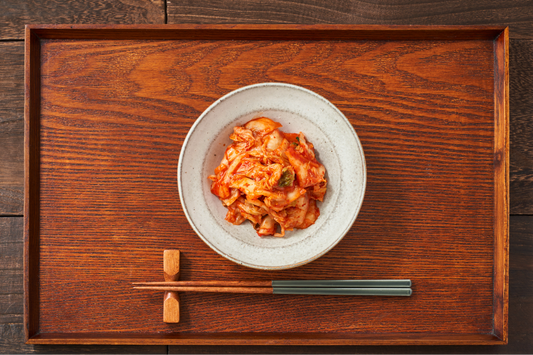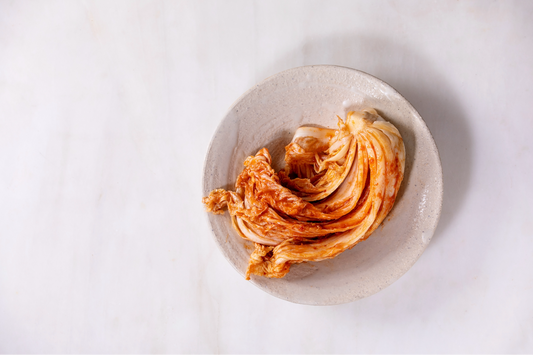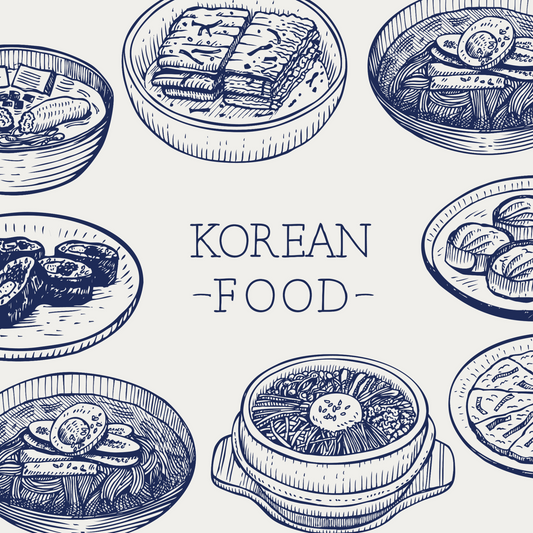Have you ever thought about turning kimchi into a main course? Kimchi dishes have won over food lovers everywhere. They range from spicy ramen to comforting Korean stew. These dishes show how fermented foods can shine in meals. Today, we're going to look at delicious kimchi recipes. As Korean cuisine gets more popular, we'll learn how to bring out kimchi's bold taste in Kimchi Ramen and Kimchi Stew.
Key Takeaways
-
Explore the variety of flavors that kimchi contributes to both quick and slow-cooked dishes.
-
Learn the art of cooking with fermented foods through traditional recipes and modern twists.
-
Understand the health benefits tied to the main ingredients in kimchi-based dishes.
-
Uncover the reasons behind the massive online following for Kimchi Stew recipes.
-
Discover pairing options that enhance the dining experience with Kimchi Ramen and Stew.
-
Gain insights into the cultural significance and community aspect of Korean cooking.
Kimchi Ramen Recipe
Looking for a tasty meal that's also easy to make? The kimchi ramen recipe mixes different flavors and textures. It transforms your dinner into something special. This dish is also part of the quick kimchi dishes, known as one of the top flavorful quick meals for any day.
Ingredients and Cooking Method for Kimchi Ramen
The main parts of this delicious kimchi noodle soup are a strong broth with gochujang paste, garlic, kimchi juice, and soy sauce. It stands out in spicy food recipes. Add veggies and soft ramen noodles for a meal that's good in protein, carbs, and fats. Begin by sautéing garlic and ginger then add broth parts to simmer. Lastly, put in the kimchi and noodles to absorb the broth's rich flavors.
Estimated Cooking Time for Kimchi Ramen
The great thing about this kimchi ramen recipe is how fast you can make it. Prep takes around 5 minutes and cooking about 10 minutes. So, in barely 15 minutes, you get to enjoy a hot bowl of delicious kimchi noodle soup. It’s a prime choice for easy kimchi-based dishes that won't hold you up in the kitchen.
Difficulty Level of Kimchi Ramen Recipe
No matter if you're skilled or new to cooking, this recipe is very simple and lets you customize. It's perfect for those wanting to try spicy food recipes or add to their list of easy kimchi-based dishes. The steps are easy to follow and you can change the spice to your liking. It's good for all cooks.
This recipe balances taste and quickness, earning a 4.86 out of 27 votes for its appeal and flexibility. It offers more than a fast dish; it's an experience in Korean cuisine. Explore more kimchi ramen tips to better this recipe and enjoy your cooking time.

Kimchi Ramen Cooking Tips
Learning how to make perfect Kimchi Ramen is an exciting journey. It starts with a few kimchi ramen tips. These will make your ramen taste and feel incredible. It's all about mixing the right flavors and spices.
We'll show you how to blend these elements for a superb ramen bowl.
Tips for the Perfect Kimchi and Ramen Combination
First, use well-fermented kimchi for a rich broth base. Using top-notch gochujang and fresh gochugaru makes it spicy and flavorful. Remember to balance the salt with low-sodium soy sauce and a bit of sugar.
Cook the noodles in the broth to soak up the flavors. Picking a quality noodle brand like Koyo elevates your dish. Add lots of fermented kimchi and chopped scallions for a tangy crunch.
Balancing Spiciness and Flavor in Kimchi Ramen
Finding the right spice and flavor mix is crucial. Start with less gochujang and add more as needed. Balance the dish with sesame oil, a little sugar, and a touch of rice vinegar.
If you're not into very spicy food, try adding tofu to reduce the heat. This lets you enjoy the kimchi benefits without overpowering spice. Kimchi ramen is great because it can be adjusted to any taste and is always delicious.
Kimchi Ramen Variations and Applications
Exploring kimchi ramen recipe adaptations reveals many flavors for all to enjoy. Various versions keep the traditional Korean stew's spirit alive. They also let everyone add their own special touch. You can choose chicken, beef, or vegetable stock. Plus, the quality of your kimchi makes a big difference in flavor.
Different Kimchi Ramen Styles and Flavor Profiles
If you like a filling meal, try adding pork belly or beef to your kimchi ramen. This adds savory depth. Vegetarians can use tofu or veggies like mushrooms and green onions instead, which adds texture and nutrients. Some even mix in meat and instant noodles, inspired by Budae Jjigae, or Army Stew, for a rich and unique taste.
Additionally, kimchi stew variations can include cheese, blending creamy and spicy flavors. To boost the health factor, add spinach or silken tofu, which are full of vitamins. With each ingredient, from broth to toppings, you turn the kimchi ramen recipe into a fun and tasty adventure. It honors traditional Korean stew while welcoming new tastes.
Customizing kimchi ramen goes beyond just the ingredients. You can also adjust cooking times, like for eggs, to get the yolk just right. Spice levels can be altered to suit your taste too. This flexibility makes the meal even more enjoyable and shows how versatile kimchi ramen is.
In short, kimchi ramen is perfect for a quick dinner or a special meal. It's rooted in traditional Korean flavors but allows for endless personalization with toppings and variations. There's always something new to try, making each bowl an exciting journey of flavors and textures.
Health Benefits of Main Ingredients in Kimchi Ramen
Kimchi Ramen is known for its delicious taste and the health benefits of kimchi stew. This well-known dish contains kimchi, a key part of Korean food, made by fermenting. This process boosts its health value.
Health Benefits of Kimchi and Key Ingredients in Kimchi Ramen
One key health benefit of kimchi stew is its support for gut health. Kimchi has good bacteria from fermentation. This bacteria helps digest food and reduces problems like constipation. The fermentation also adds vitamins, raising the dish's nutrition.
Kimchi also helps the heart by making compounds like CLA that lower blood pressure. It helps control blood sugar and supports a healthy weight. This shows how using fermented foods daily can be good for health.
Kimchi's anti-inflammatory qualities add to Kimchi Ramen's health benefits. Active parts in kimchi bring vast health advantages. It improves both the dish's taste and its positive impact on health.
However, there are some side effects to note, like bloating or gas for those new to fibrous or fermented foods. People sensitive to histamine or on low-sodium diets should be cautious with kimchi.
In summary, the kimchi benefits in Kimchi Ramen are many. They promote gut health, heart health, and reduce inflammation. Making it a nutritious and delicious meal choice.
Taste and Aroma of Kimchi Ramen
The scent of Kimchi Ramen starts an exciting journey for your senses. It's a delicious kimchi-based dish that mixes spicy kimchi with rich vegetable broth and noodles. The blend of gochujang's sharpness and gochugaru's mild heat creates a unique aroma. This promises a bold taste that's sure to please.
Unique Flavor Profile and Aroma of Kimchi Ramen
Ingredients like soy sauce, ginger, and garlic make Kimchi Ramen smell amazing. They also boost the broth's taste, making each spoonful memorable. Kimchi adds a tangy punch that balances the richness. Umami from mushrooms and tofu makes it filling. Toasted sesame oil adds a nutty touch, enhancing the dish's flavors.
The flavorful kimchi noodle soup is not just tasty. It also offers different textures. Silky noodles, tender tofu, and crunchy vegetables like edamame and scallions make it exciting. This mix not only delights your taste buds but also your eyes. It turns eating Kimchi Ramen into a complete experience.
This dish takes about 40 minutes to make. It's perfect for a hearty and warm meal that is good for you too. While it cooks, the spicy, sour, and savory smells make your kitchen inviting. Whether for lunch or dinner, Kimchi Ramen is a highlight of Korean cooking and comfort.
Recommended Side Dishes and Drinks for Kimchi Ramen
Choosing the perfect side dishes and drinks for kimchi ramen pairing is key. You have over 21 unique recipes to pick from. Choices range from light dishes like Hamachi Crudo and Vegetarian Sushi Spicy "Tuna" Rolls, to rich options such as Smoked Beef Short Ribs and Kimchi Fried Rice. Each one adds a special touch to your meal.
Quick meals like Bacon Fried Rice or Sweet and Spicy Chicken Wings pair well with the bold flavor of kimchi ramen. For a unique taste, try Cumin Lamb Noodles or Korean Oven Braised Short Ribs. They match the deep flavor of kimchi ramen perfectly.
Matching these dishes with a refreshing drink is essential. Options like light beers, soju, or cold barley tea are great. These drinks cool down the spicy kick and let the rich flavors shine without overpowering your taste buds.
Whether you choose something bold like Udon Noodle Soup or a softer Vegetarian Bibimbap, the goal is to blend textures and tastes. This balance makes every bite interesting. This careful selection of sides not only makes your meal better but also highlights kimchi's worldwide popularity in food.
Kimchi Stew Recipe
Starting to make a kimchi stew recipe is an exciting dive into traditional Korean food. This beloved dish shines with its strong taste, thanks to the fermented kimchi. It's great because you can add pork, beef, or tuna to it.
Ingredients and Cooking Method for Kimchi Stew
The heart of a great kimchi stew recipe lies in using well-aged, sour kimchi. This gives the stew its rich flavor. It's made with ingredients like pork belly without skin, shiitake mushrooms, tofu, and a mix of green and brown onions. The kimchi stew cooking method brings these together in a tasty broth. It's spiced with gochugaru (Korean chili flakes), soy sauce, gochujang (Korean chili paste), and garlic. For those who don't eat meat, you can use an anchovy broth instead. This keeps the stew's traditional taste.
Estimated Cooking Time for Kimchi Stew
Making this traditional Korean stew usually takes between 20 to 30 minutes. During this time, the flavors blend well. The process of cooking kimchi and pork together enhances both. The kimchi gives the pork a tangy flavor and makes it tender.
Difficulty Level of Kimchi Stew Recipe
Even with its complex taste, this quick traditional Korean stew is quite easy to make. This simplicity makes it perfect for beginners and enjoyable for experts. With easy kimchi stew variations, you can change the meat or broth. This allows you to be creative without losing the dish's original flavor.
The kimchi benefits in this stew are amazing. It's not just tasty; it's also healthy. It's packed with vitamins and probiotics that help with digestion. Each bite is not just good for your taste buds. It also brings nutritious value to your meal. Whether you stick with pork or try something new, kimchi stew is a recipe you've got to try. It's a wonderful way to explore Korean cuisine.
Kimchi Stew Cooking Tips
Exploring traditional Korean dishes shows the importance of kimchi stew cooking. It's crucial to choose the right kimchi for flavor. Extra fermented kimchi works best due to its deep taste. It blends well with pork belly, tofu, or seafood in the stew.
Choosing the Best Kimchi and Ingredients for Kimchi Stew
For kimchi stew, pick fermented, sour, and robust kimchi. It forms the stew’s base. Add top-notch tofu, pork, or tuna to improve texture and flavor. Anchovy broth or beef broth and seasonings like gochujang, gochugaru, and sugar fine-tune the stew’s taste.
Secrets to Achieving Depth of Flavor in Kimchi Stew
To make great kimchi stew, focus on its flavor depth. Combine salty, sweet, and spicy tastefully. Begin with well-fermented kimchi and sauté garlic and onions for base aroma.
Add main ingredients, careful of cooking times to keep textures. Slow cooking mixes everything well, enriching the flavors. Serve it with steamed rice and fresh green onions to boost its hearty taste.
The beauty of kimchi stew lies in its flexibility and the personal spin every chef adds. This makes each pot a special part of Korean culinary art.

Kimchi Stew Variations and Applications
The kimchi stew recipe is not just for pork and kimchi. It's a perfect dish for creative cooks. Kimchi stew variations bring together classic and new flavors. This makes it great for all kinds of taste preferences. The traditional stew is loved in Korea. It's a comfort food that encourages new ideas.
Creative Variations of Kimchi Stew for Different Palates
You can try different meats like mackerel, pork neck bones, or tofu in kimchi stew. This change can make the stew feel and taste different. It's also a way to make the dish fit different diets and boost its health benefits. For those who love creative kimchi dishes, adding rice cakes or gochugaru can change the spice level. This way, it can be mild or very spicy.
Adding cheese to a kimchi stew recipe might sound strange. But it creates an exciting mix of flavors. Each twist on the recipe is a chance to discover Korean cooking. It also celebrates the unique taste and smell of kimchi.
Kimchi stew is special whether it's in traditional 'ddukbaegi' or a modern pot. It brings together many flavors and traditions. It's loved in simple and fancy places. Every cook adds something special to the recipe. This shows how flexible and popular Korean food is.
Health Benefits of Main Ingredients in Kimchi Stew
Kimchi stew is packed with nutritional benefits, thanks to its main ingredient, fermented kimchi. This Korean dish is famous for its strong flavors and health perks. The benefits of kimchi make it a great choice for your meals.
Kimchi is loved for its probiotics, which are good bacteria that help your gut health. It's full of vitamins K and C, plus iron, which are all important for staying healthy. With only 23 calories per cup, kimchi gives you 2 grams of fiber to help digestion and keep you feeling full longer.
Health Benefits of Fermented Kimchi and Other Key Ingredients in Kimchi Stew
Eating dishes with fermented kimchi is good for you. The lacto-fermentation process makes it easier for your body to get nutrients from the food. Kimchi's probiotics aid digestion, boost your immune system, and help reduce inflammation.
Kimchi has a special type of Lactobacillus bacteria that lowers inflammation and could protect against chronic diseases. It might even improve heart health by managing cholesterol levels. Eating kimchi regularly can decrease "bad" LDL cholesterol and increase "good" HDL cholesterol.
Kimchi stew also has garlic, ginger, and chili peppers that boost its health value. Garlic helps with heart health and managing blood pressure. Ginger reduces nausea and fights inflammation, adding more benefits.
Kimchi stew is also good for managing your weight. Studies show that it can help reduce body weight and fat. This makes kimchi stew a delicious and healthy choice for those watching their weight.
Each element of kimchi stew combines to offer a dish that is not only tasty but also healthy. It's a wise choice for anyone looking to eat better.

Taste and Aroma of Kimchi Stew
The unique taste and smell of kimchi stew are deep in tradition. Its spicy, fermented aroma wakes up your senses. The first whiff mixes sharp and warm spices, inviting you to explore more.
Distinctive Flavor and Aroma of Kimchi Stew
The stew tastes as rich as its history. Every bite combines umami from kimchi with pork and tofu. It's based on a strong stock, with kimchi juice adding tang and sweetness. This counters the heat from Korean chili flakes, gochugaru.
The mix of cabbage, pork, tofu, garlic, and ginger is perfect for modern tastes. Fermentation gives kimchi a range of flavors, from tangy to spicy. While cooking, these flavors blend into a warm, inviting dish.
Kimchi stew links us to cultural roots and showcases Korean cooking. It's a dish that stays true to tradition while appealing to today's tastes. Truly, it nourishes just as much as it satisfies.
Recommended Side Dishes and Drinks for Kimchi Stew
Kimchi Jjigae is not just known for its bold flavors. It also pairs well with many sides and drinks. These pairings can turn a simple bowl of stew into a lavish meal. Let’s look at the best side dishes for your kimchi stew.
Ideal Side Dishes and Beverages to Complement Kimchi Stew
A bowl of hot steamed rice is the classic side for kimchi jjigae. Rice absorbs the stew's rich flavors, like spicy kimchi and tender pork belly. For a fun texture twist, try Korean pancakes. They add a crispy bite. A cool cucumber salad with sesame oil adds a refreshing crunch.
Pairing drinks with kimchi jjigae? Light-bodied beers cut through the stew’s spice. Or choose traditional teas for a soothing touch. They should either calm or contrast the stew's taste. With these ideas, your next kimchi stew meal will be a delightful experience. It shows the beauty of Korean stew pairing.
FAQ
What dishes can I make with kimchi?
Delicious dishes with kimchi include Kimchi Ramen and Kimchi Stew. They are spicy, traditional Korean dishes. They take advantage of fermented foods' flavor.
What are the ingredients for Kimchi Ramen?
Kimchi Ramen needs well-fermented kimchi, noodles, and veggies like garlic and onions. It also uses gochujang and gochugaru for Korean taste.
How long does it take to cook Kimchi Ramen?
Cooking Kimchi Ramen takes 20 to 30 minutes. This includes both prep and cooking time.
Is Kimchi Ramen difficult to make?
Making Kimchi Ramen is easy. It's great for any cooking skill level. The recipe is adaptable.
What are some tips for balancing the flavors in Kimchi Ramen?
Start with less spice and adjust as you go. Use sugar to lessen the heat. Make sure the kimchi is well-fermented. Use soy sauce and sugar to balance bold flavors. Adding tofu can soften the spice.
Can Kimchi Ramen be made in different styles?
Yes, you can tweak Kimchi Ramen to your taste. Add different meats or veggies. Even instant noodles work for a quick meal.
What are the health benefits of the ingredients in Kimchi Ramen?
Kimchi boosts digestive health with probiotics. Garlic and ginger fight inflammation and are antioxidants. Veggies add vitamins and fiber.
What does Kimchi Ramen taste and smell like?
Kimchi Ramen smells like fermented kimchi. It tastes spicy, tangy, and rich. The broth is savory, pleasing your taste buds.
What sides or drinks go well with Kimchi Ramen?
Pair Kimchi Ramen with Oi Muchim or steamed rice. Light beers or soju match its spice well.
How is Kimchi Stew (Kimchi-jjigae) different from Kimchi Ramen?
Kimchi Stew is heartier with pork and tofu in anchovy stock. It's umami-rich. Kimchi Ramen, however, is lighter with noodles for quick serving.
What are some secrets to achieving depth of flavor in Kimchi Stew?
For deep flavor in Kimchi Stew, use ripe kimchi and quality meats. Begin with seasoned aromatics. Add seasonings and simmer to blend the flavors.
How can I vary my Kimchi Stew?
Alter Kimchi Stew by trying different meats or kimchi types. Add rice cakes or cheese for a new twist.
Can Kimchi Stew be paired with side dishes?
Serve Kimchi Stew with steamed rice for a balanced taste. Kimchijeon or cucumber salads add contrast to your meal.









